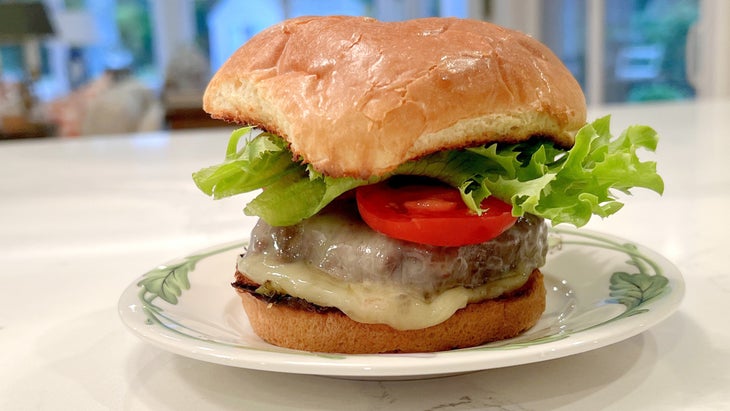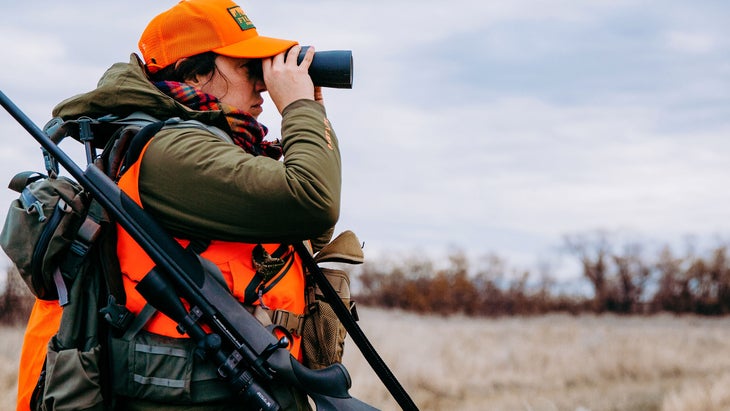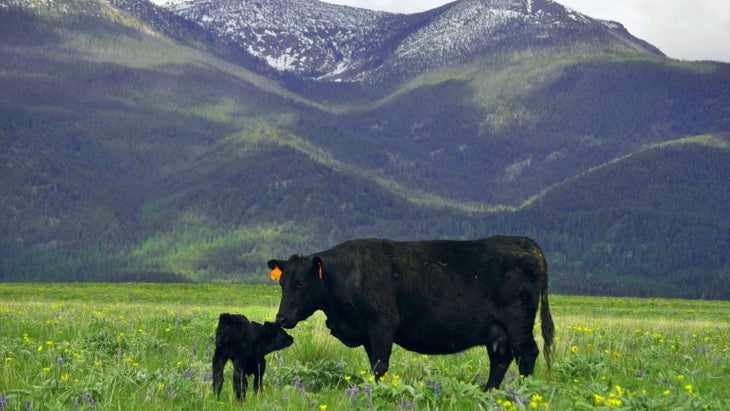I like a good burger as much as the next girl. This past weekend at a family cookout, I indulged in a damn good one. But each delicious beefy bite brought with it a bitter aftertaste. You see, I’m an environmentalist hell-bent on making daily choices that support a healthy planet. And beef, I’m sure you’ve heard, has a hefty environmental impact. According to Project Drawdown, switching to a plant-based diet and reducing food waste are by far the we can take.
The meat and dairy industries account for about 14.5 percent of global greenhouse gas (GHG) emissions and are also the leading causes of deforestation. And when you compare the GHG emissions from different food groups, beef takes the prize by a landslide.

So what’s a beef-loving environmentalist to do? Can I stay true to my climate values without swearing off meat? Can I enjoy the occasional steak without feeling like a total hypocrite? Can I source beef that supports a healthy planet rather than depletes it?
Hoping that the answer to these questions was a resounding yes, I turned to three passionate environmentalists–a climate scientist, a hunter, and a rancher. None of them think we��need to quit beef altogether—instead, we need to rethink our relationship to beef and where it comes from.
I came away from my conversations with three guiding principles about my future beef ��consumption: eat less, don’t waste any of it, and buy the best I can find and afford.
Eat Less Beef
The topic of meat and its impact on the environment gets a lot of heat and not a lot of light, says Dr. Jonathan Foley, executive director of , a nonprofit whose mission is to stop climate change as quickly, safely, and equitably as possible using science-based solutions and strategies.
“The science is really clear,” says Foley. “Red meat is a huge environmental force. 75��percent of all agricultural land in the world is used to raise animals.”
Roughly 99 percent of American beef is “finished” in feedlots, says Foley. That means that while the calves may live on an open range for the first year of their lives, they’re then shipped to giant commercial operations where they’re prevented from moving around and fed a steady diet of grain to fatten them up and create the desired marbling.
“We’re devoting a huge amount of land, water, and chemicals to grow massive grain monocrops for animal feed, which is detrimental to biodiversity and a healthy planet,” says Foley.
This is compounded by the fact that Americans eat far too much beef: about 83 pounds per person per year, according to data from the��, second only to Portugal.
Practices like regenerative ranching—which seeks to improve soil health and increase biodiversity—and avoiding consumptive feedlot beef��may be part of the solution, but only if we dramatically cut the amount we consume in the first place, contends Foley.
“Cutting back is the only way pencils out. We simply don’t have enough grassland to support the volume of beef we’re consuming,” he says. “Regenerative ranching only makes sense if we drastically cut consumption.”
Respect Meat—and Waste None
Nicole Qualtieri is a longtime hunting , the editor-in-chief of an outdoors publication called , and a passionate conservationist who traded high heels for hiking boots when she moved to Montana from Denver and took up hunting a decade ago. She often writes about her connection to the land and how .
 Qualtieri glasses the countryside for mule deer in eastern Montana. (Photo: Lindsey Mulcare)
Qualtieri glasses the countryside for mule deer in eastern Montana. (Photo: Lindsey Mulcare)“Hunters and vegans have more in common than less,” says Qualtieri. “We are both actively involved in our foodways. But most vegans still depend on industrial food entirely for what they eat, plants included. I think it’s great that they shun industrial meat and animal products that lack integrity; however, there are other routes to breaking systemic dependence.”
For Qualtieri, part of breaking that dependence is eating as much of the animal as possible, whether it’s store-bought beef or an elk she’s killed.��Wanton waste laws (which vary by state) prohibit hunters from leaving meat behind. “Here in Montana, wanton waste laws mean that for cervids (deer, elk, and moose), hunters have to take the four quarters, two backstraps, and tenderloins. I choose to take much more. For me, hunting necessitates a deep participation in the landscape—learning about game trails, animal behavior, seasonality, and more. It’s beyond empowering to walk into the wilderness alone, kill an animal if the right moment occurs, process it, butcher it, and cook it with care and respect,” she says. In her efforts to minimize food waste, she’s become a more adventurous omnivore. “I eat heart, tongue, organs, and strange cuts on a regular basis from the animals I kill,” she says.
Every fall, Qualtieri’s goal is to fill her freezer with wild game that will last her through to next season. “It lowers my grocery bill, it’s than store-bought, feedlot-raised beef, and I eat less of it because it’s precious. I have pulled myself out of industrial meat for the most part, and that feels like a huge win.”
When Qualtieri does buy beef, she typically buys it in bulk, and gets best quality she can find, which for her means locally sourced in Montana and raised far away from the feedlots. “My family occasionally pitches in on a beef quarter from a local rancher, which goes a long way,” she says.
How to Source the Best Beef
When shopping for meat, the labels can be confusing and confounding, and the fact of the matter is that the vast majority of stuff we find in the grocery store is of the industrial, grain-fed variety.
There are far better options. Cole Mannix is the president and founder of the , a company whose motto is “meat with integrity.” Mannix, a fifth-generation regenerative Montana rancher, believes that animal-based agriculture has the power to both produce nourishing food, maintain and improve long-term ecological health, and leave space for wildlife.
Mannix, like Foley and Qualtieri, is both an environmentalist and a carnivore. He wants people to not only think about where their food comes from, he wants people to actually see where it comes from. “I want people to develop and deepen a friendship with the people and�� landscape behind their food.”

That’s why he created the��Old Salt Festival, a of Montana land stewardship, now in its second year. The festival, which melds wood fire cooking, Americana music, local makers, and educational meadow walks on the Mannix Family Ranch, had 1,600 attendees in 2023.
“The deadest landscapes I’ve ever seen are monoculture commercial grain farms,” says Mannix. “What I’m trying to show people is another way: cattle ranches that are wild, wide-open landscapes with grizzlies, birds, and abundant wildlife. Places with healthy riparian areas and biodiversity. Biodiversity is a sign that a place is alive.” Mannix does this by rather than trying to fight it with chemicals and “mimicking the symbiotic role that native ruminants (grazing mammals) had with grasslands.”
But what about someone like me–an east-coaster who’s about 2,500 miles from Big Sky country? I asked Mannix for tips on how to shop ethically for meat in my area. I’ve been perplexed in the store by the myriad labels on beef: grass-fed, grass-finished, regenerative, organic, free-range, and more.
“I can’t point people to one single label on a beef product that would tell them it’s better,” he says. “Labels do not reflect the landscapes. My advice is to research the landscape behind your food and make your own decision. Look for beauty because beauty is a sign of life. Only healthy soil and intact ecological function can support life. Soils that are teeming with life mitigate climate change.”
Mannix’s skepticism about misleading labels and his advice to really think about the suppliers behind everything we buy makes perfect sense to me. But I wanted to learn more about how anyone, regardless of their location, resources, or food budget, can find ethical beef. Like the frazzled working parent with a bunch of mouths to feed, rushing to the local market between her day job, dentist appointments, baseball games, and carpools.
After loads of research, I’ve come to believe that there are, sadly, no short cuts for busy moms like me. If you see labels like like “grass-finished,” and “regenerative” in the store, they can be a starting point. On the spot, you can whip out your phone and navigate to the brand’s website. Read the About Us section to learn about its land stewardship values and maybe see photos of the farm. When ranchers cherish the landscape, you’ll know it because they talk about it and show it on their websites.
If it feels right, put that burger meat in your cart and make that chili tonight. And keep learning. At home, when you have a minute to breathe, continue researching the brands you have local access to. While you’re at it, look up some delicious vegetarian chili recipes to work into your rotation.
The people I interviewed for this piece showed me that you can be an environmentalist and still eat beef, if you do it thoughtfully and intentionally. For me, that means practicing my new non-hypocritical meat-loving environmentalist mantra: Eat less, waste none, and do the best I can to buy from regenerative farms I trust. I’ve already placed an order for a with Old Salt and it should last me for about six months.
Doing right by the planet can make you happier, healthier, and—yes—wealthier. �����ԹϺ���’s head of sustainability, Kristin Hostetter, explores small lifestyle tweaks that can make a big impact. for her twice monthly newsletter or write to her at climateneutral-ish@outsideinc.com.
